|
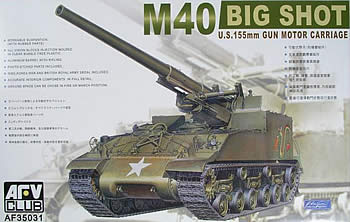 AFV
Club AFV
Club
35031
Historians
generally accept that artillery assets of the US Army were exceptional in WW2.
Self-propelled artillery was a vital component of this American firepower. The
M40 was the logical development of the highly successful, albeit few in number,
M12 self-propelled gun. The M12 mated an M3 chassis with a 155mm gun that was
derived from the WW1 era French GPF. The M12 proved its worthiness in Europe and
planners moved to mount the more modern M1 155mm Gun or “Long Tom” onto
a suitable chassis. To ease manufacturing, it was decided to use existing components
from M4 Medium “Sherman” production. The
T83 (the pilot designation of the M40) used the general layout of the M12 –
having the gun in the rear and moving the engine compartment to the center. The
drivers’ stations would be forward of the engine compartment. The T83 added
gun mount fittings, ammo stores and protective walls for the gun crew. The chassis
was a widened and lowered version of the M4A3, utilizing HVSS suspension and 23-inch
wide tracks while the drivers used cupolas previously used on M4 turrets. It was
powered by the Continental 975C4 radial engine and provided 395 HP for the 42
ton vehicle. The T83 pilot was completed in July 1944. Initial tests went well
and full production began in February 1945. It was designated the 155mm gun motor
carriage M40 in May 1945. A complimentary project, the T89, mounted the similar
M1 8” howitzer onto the same chassis as the T83. The T89 became the 8”
howitzer motor carriage M43 in November 1945. The production numbers for each
were 418 M40s (with 24 converted to M43s) and 48 M43s. Two
pilot chasses for the T83 and T89 were prepared for combat evaluation and saw
action before war’s end. The M40 and M43 lines would see significant action
in Korea as forces were gathered there to battle Communist armies. The M40 and
M43 were maintained in reserve service into the 1960s including some given to
the UK. AFV
Club of Taiwan has finally released their eagerly-awaited M40 kit, first announced
several years ago. Even some of the sprues denote “2004”. Given that
they issued the excellent M59 155mm “Long Tom” and M1 8” Howitzer
kits several years ago, this was a logical development. The M40 has the typical
fine artwork of AFV Club kits. Inside are 9 sprues, an aluminum barrel (with rifling),
a PE fret, vinyl T66 tracks, a clear plastic sprue for the cupolas and tail lights
and a decal sheet with markings for 7 versions. 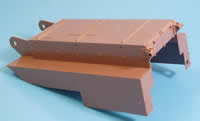 Hull
and Suspension Hull
and Suspension
AFV Club provides the large hull tub minus the rear bulkhead
as one large piece. Fine details are provided including fine weld seam details
along the front and rear edges and on the internal join where the sponson floor
meets the hull wall. Casting numbers are in place near the join line of the transmission.
Modelers used to M4-type transmissions will note the “nose-down” cant
of the M40’s transmission cover. 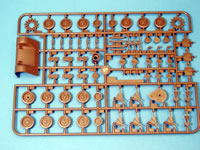 This
was a modification needed to slant the nose lower due to the angle of the propeller
shaft since the engine was moved forward. Details for the hull bottom are also
included. The drive sprocket mount has some casting texture on its surface but
the transmission housing is a bit too smooth for my taste. It does have a nice
set of stamped casting numbers, though. This
was a modification needed to slant the nose lower due to the angle of the propeller
shaft since the engine was moved forward. Details for the hull bottom are also
included. The drive sprocket mount has some casting texture on its surface but
the transmission housing is a bit too smooth for my taste. It does have a nice
set of stamped casting numbers, though.
AFV
Club includes their excellent HVSS set (sold separately as 35030) originally released
years ago. It requires you add two vinyl “volute” springs which allow
the suspension to rock like the real thing. Casting texture is present on the
major housings as well as casting numbers in the appropriate locations. Having
built two of the HVSS sets before, they can be a bit fiddly but the final result
is well worth the effort. Another great feature is the absence of seam lines on
the various wheels. The idler mount is nicely detailed and matches the actual
item (HVSS idler mounts were annoyingly omitted in the AFV Club kit 35030). Drivers’
Area and Glacis
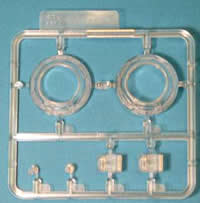 The
upper front of the M40 and glacis are very busy areas. AFV Club’s inclusion
of two clear plastic cupolas is a nice touch. You also get rear lights and periscopes
on that sprue. When painted up, the translucency of the clear part does add another
dimension of accuracy to the final project. No interior details are provided but
I wouldn’t be surprised if Hobby Fan or VP doesn’t release one quickly.
The armored ventilator has a small sink mark that will easily be corrected with
putty. Nice weld beads around the cupola splash protectors top off the drivers’
area. The
upper front of the M40 and glacis are very busy areas. AFV Club’s inclusion
of two clear plastic cupolas is a nice touch. You also get rear lights and periscopes
on that sprue. When painted up, the translucency of the clear part does add another
dimension of accuracy to the final project. No interior details are provided but
I wouldn’t be surprised if Hobby Fan or VP doesn’t release one quickly.
The armored ventilator has a small sink mark that will easily be corrected with
putty. Nice weld beads around the cupola splash protectors top off the drivers’
area. 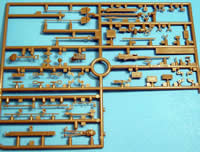 Atop
the engine you get a nice set of pioneer tools. This sprue is marked 35024, from
their M10 Tank Destroyer kit. The tools have molded-on straps and brackets. The
complex gun travel lock is nicely rendered but you'll want to remove the small
rectangular seam around the lock's base on the glacis. You get the option of having
empty spare track racks (done in PE) or ones mounting T84 rubber chevron tracks. Atop
the engine you get a nice set of pioneer tools. This sprue is marked 35024, from
their M10 Tank Destroyer kit. The tools have molded-on straps and brackets. The
complex gun travel lock is nicely rendered but you'll want to remove the small
rectangular seam around the lock's base on the glacis. You get the option of having
empty spare track racks (done in PE) or ones mounting T84 rubber chevron tracks.
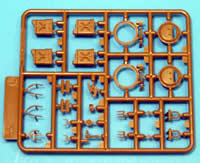 The
headlights are mediocre (part D2) and you get the typical plastic light and siren
guards (best rendered in PE). Three PE screens are provided for the appropriate
engine air inlet (central vent) and air outlets (2 aft vents). Note that the two
nubs on the outlet deflectors and the two nubs outside the deflectors should actually
be tie-down loops for a canvas shroud that was sometimes attached. Outside of
both air outlets are two impressions where a handle should be placed, as well.
A very nice feature is cast letters that say “gasoline” and “lubricating
oil” by the armored vents. The
headlights are mediocre (part D2) and you get the typical plastic light and siren
guards (best rendered in PE). Three PE screens are provided for the appropriate
engine air inlet (central vent) and air outlets (2 aft vents). Note that the two
nubs on the outlet deflectors and the two nubs outside the deflectors should actually
be tie-down loops for a canvas shroud that was sometimes attached. Outside of
both air outlets are two impressions where a handle should be placed, as well.
A very nice feature is cast letters that say “gasoline” and “lubricating
oil” by the armored vents.
Fighting
Compartment and 155mm Gun
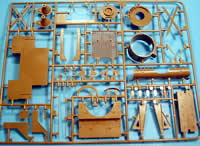 Obviously
the most distinctive feature of the M40 is this area. AFV Club’s M59 “Long
Tom” 155mm gun is here in its resplendent finery. Still one of the best 1/35
artillery kits around, the M40 kit takes it a step further by providing an aluminum
barrel with about 5mm of rifling in the muzzle. Obviously
the most distinctive feature of the M40 is this area. AFV Club’s M59 “Long
Tom” 155mm gun is here in its resplendent finery. Still one of the best 1/35
artillery kits around, the M40 kit takes it a step further by providing an aluminum
barrel with about 5mm of rifling in the muzzle. 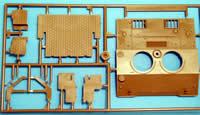 The
original M59 kit (AFV Club 35009) did not have the muzzle rifling. Included is
the entire C sprue from kit 35009. While there are a number of small parts to
the gun, it is not excessive. All these parts were molded well with just a minimal
of ejection marks and seam lines. Note that prominent parts C31 and C43 should
join C10 and C11 with no seam line – putty is required here. The shell loading
tray have intricate parts (A11, A5) and must be carefully removed from the sprue. The
original M59 kit (AFV Club 35009) did not have the muzzle rifling. Included is
the entire C sprue from kit 35009. While there are a number of small parts to
the gun, it is not excessive. All these parts were molded well with just a minimal
of ejection marks and seam lines. Note that prominent parts C31 and C43 should
join C10 and C11 with no seam line – putty is required here. The shell loading
tray have intricate parts (A11, A5) and must be carefully removed from the sprue. 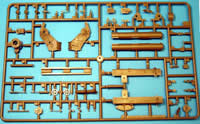 Around
the fighting compartment itself, you get the horizontal ammo racks, wall-mounted
storage bins, crew seats, floor bins, gun mount and air cleaners from the engine
firewall. The M43 HMC had vertical universal ammo stores whereas the M40’s
racks were designed for 155mm ammunition. The crew seats were folded up during
firing missions. The seat mounts on the storage locker walls are detailed to allow
you the option of omitting the seats altogether as I can imagine occurred during
imagine prolonged static firing missions. Around
the fighting compartment itself, you get the horizontal ammo racks, wall-mounted
storage bins, crew seats, floor bins, gun mount and air cleaners from the engine
firewall. The M43 HMC had vertical universal ammo stores whereas the M40’s
racks were designed for 155mm ammunition. The crew seats were folded up during
firing missions. The seat mounts on the storage locker walls are detailed to allow
you the option of omitting the seats altogether as I can imagine occurred during
imagine prolonged static firing missions. 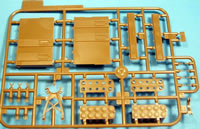 Photos
show that the seat back had two small handles along its lower length where seatbelts
attached. Atop the storage locker lids, the kit provides butterfly screws. The
air cleaners have nice mounting strap details. In some photos, the compartment
in the right rear corner where the directions have you placing a jerry can, four
universal rifle rack clips are seen. The Tech Manual has a separate arrangement
but I have not seen any “in action” photos of the “official”
rifle racks in place. Photos
show that the seat back had two small handles along its lower length where seatbelts
attached. Atop the storage locker lids, the kit provides butterfly screws. The
air cleaners have nice mounting strap details. In some photos, the compartment
in the right rear corner where the directions have you placing a jerry can, four
universal rifle rack clips are seen. The Tech Manual has a separate arrangement
but I have not seen any “in action” photos of the “official”
rifle racks in place.
Spade
and M40 rear
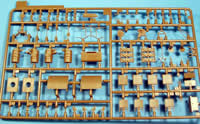 The
complex spade, ramp and ramp extension are excellently molded by AFV Club. The
zig-zag detail of the ramp floor (F2) and the fine grate of the ramp extension
(B8) are molded with great finesse. You must decide to model these in stowed and
upright positions or extended for combat operations. Some sink holes are present
in parts B5, 6, 24 & 25. B5 & B6 are prominent while 24 & 25 get hidden
away. The winch system for the ramp is well done with photos of the real winch
in the directions. A length of string is included for the winch. Parts F7 and
F8 have a grab handle that I damaged through careless packing of the sprue back
into the full box (you might want to carefully remove these parts upon kit receipt). The
complex spade, ramp and ramp extension are excellently molded by AFV Club. The
zig-zag detail of the ramp floor (F2) and the fine grate of the ramp extension
(B8) are molded with great finesse. You must decide to model these in stowed and
upright positions or extended for combat operations. Some sink holes are present
in parts B5, 6, 24 & 25. B5 & B6 are prominent while 24 & 25 get hidden
away. The winch system for the ramp is well done with photos of the real winch
in the directions. A length of string is included for the winch. Parts F7 and
F8 have a grab handle that I damaged through careless packing of the sprue back
into the full box (you might want to carefully remove these parts upon kit receipt).
Markings
 The
decal sheet has markings for the single vehicle used in WW2 (T83 pilot), 5 US
Army Korean war examples and a British version (there's some question to the actual
use dates by the British). The WW2 T83 and other early models used the T66 tracks
included in the kit. The suggested profile of the WW2-era vehicle shows the black/OD
pattern that is corraborated in a photo of it outside Cologne. However, Korean
War M40s are seen in T80 steel chevron and T84 rubber chevron tracks. In period
photos, some M40s tracks can be seen:“Aita’s Ankies” (T80) and
the colorful dragon of the 204th FA (T84). “CYO CHARISSE” should be
marked as “CYD CHARISSE” and is actually with the 937th FA, not the
204th FA. The
decal sheet has markings for the single vehicle used in WW2 (T83 pilot), 5 US
Army Korean war examples and a British version (there's some question to the actual
use dates by the British). The WW2 T83 and other early models used the T66 tracks
included in the kit. The suggested profile of the WW2-era vehicle shows the black/OD
pattern that is corraborated in a photo of it outside Cologne. However, Korean
War M40s are seen in T80 steel chevron and T84 rubber chevron tracks. In period
photos, some M40s tracks can be seen:“Aita’s Ankies” (T80) and
the colorful dragon of the 204th FA (T84). “CYO CHARISSE” should be
marked as “CYD CHARISSE” and is actually with the 937th FA, not the
204th FA. Conclusion
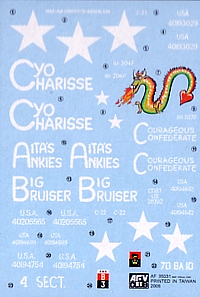 This
is an overall excellent kit of a significant vehicle in the US inventory in terms
of development and historical implementation. AFV Club's great research and kit
engineering are extremely appreciated. With only the need for possible alternative
tracks, I can not see why this kit does not deserve the highest recommendations. This
is an overall excellent kit of a significant vehicle in the US inventory in terms
of development and historical implementation. AFV Club's great research and kit
engineering are extremely appreciated. With only the need for possible alternative
tracks, I can not see why this kit does not deserve the highest recommendations. Recommended
References
Photos of the M43 Howitzer Motor Carriage will be very useful
for the detailer:
http://www.toadmanstankpictures.com/m43.htm
http://www.toadmanstankpictures.com/m43pt2.htm A
great resource is Mike Powell’s CD of the tech manual, Easy1Productions product
T029, available here. A
very difficult to find item is the M40 155mm Gun Motor Carriage, Military
Vehicle Workshop Series #27 by Sid Arnold of Armoured Brigade Models. They include
many images from the M40 and M43 tech manuals. 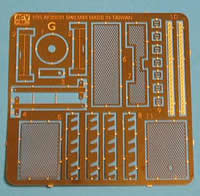 Other
useful books are the following: Other
useful books are the following:
US
Armored Artillery of WW2, by Steve Zaloga. Concord Publications.
Tank
Warfare in Korea, by Steve Zaloga. Concord Publications.
Armor in Korea,
by Jim Mesko. Squadron Signal
Sherman, by RP Hunnicutt. Presidio. A
veteran of the 937th FA has some notes here.
-Roy
Chow | 












 AFV
Club
AFV
Club











